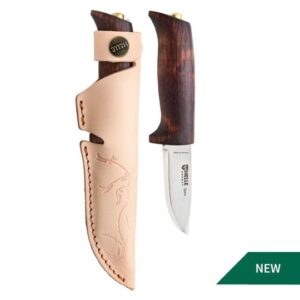Helle knives, Norwegian quality
- Helle knives , a family business rich in tradition and quality, handed down for generations, Knives created in the smallest town in Norway. Norwegian knives created for the hands of real men and women who love life in nature.
Why buy one?
Made in Norway, Helle guarantees the highest quality of their blades, forged from an ancient tradition, created in the cold Norwegian lands, Helle knives are designed for all outdoor activities, whether it is Survivor, Bushcraft or woodworking with these knives you will have the maximum guarantee of quality and reliability
- Built with traditional materials
- Made to be used, Helle knives will accompany you on every adventure!
- Guaranteed for life,
- Helle has been producing Scandinavian knives since 1932
Our selection
How to take care of your blade?
Hell e knives are made to accompany you on your adventures. They are tools made to be used and will work best if maintained and treated correctly.
- Keep the knife clean and dry after use.
- If used to cut meat or fish, it is advisable to rinse the knife with warm, fresh water and a little more delicate type of cleaning detergent.
- Dry the knife with a soft cloth.
- Periodically treat the handle with oil or wax. Preferably a natural and not fossil-based product, for example beeswax.
- Treat the blade with grease or oil. Especially important if you have a carbon steel blade.
- Treat the sheath with colorless impregnation. Non-acidic grease or wax such as saddle grease or dubbin. This will keep the skin supple and keep its shine.
- Dry the sheath thoroughly at room temperature if it gets wet.
- Never dry wood or leather near fire or stove to dry quickly.
Sharpening - Helle knives are known for sharpening outside the box. Maintaining a good sharpness is important to maintaining the performance of yours
- knife. It is recommended to use traditional flat sharpening stones or a sharpening stone. The level of wear of the cutting edge determines the grain size to be used to restore the knife to its original sharpness.
The sharpening method used on a Helle knife is a classic Scandi grind. This means there is only one angle to refine as shown in the image. Or a secondary secondary cutting angle like on some of our Knives from the Fishing collection.
How to sharpen
Place the knife bevel on the sharpening stone and work the entire blade one stroke at a time. Push the blade towards the edge. Like the cut.
Work only one side until you feel a cutter on the opposite side. Switch sides and repeat the process until you feel the cutter on the first side. You have now established an advantage.
Switch to a finer stone if you want to improve further.
Finish by gently stroking the blade on a fine whetstone on both sides, as if cutting very thin slices. Keep the bevel flat towards the stone and move it from side to side until the burr disappears.
Depending on the use of the knife, keeping a light cutter can be a good thing. For the best possible result, take a look at our selection of sharpening stones and accessories. (Coming soon).



